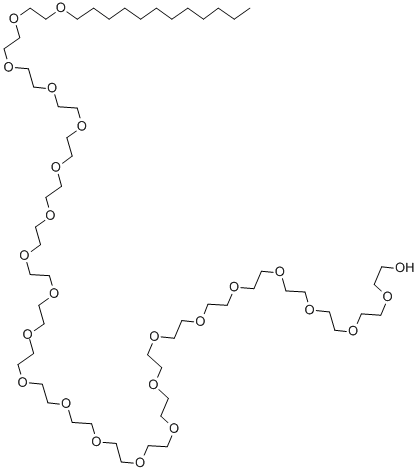Polyoxyethylene lauryl ether
Synonym(s):Brij 35;Polidocanol;Lauromacrogol;Polyethylene glycol dodecyl ether;Coceth-10
- CAS NO.:9002-92-0
- Empirical Formula: C58H118O24
- Molecular Weight: 1199.55
- MDL number: MFCD00043375
- EINECS: 500-002-6
- SAFETY DATA SHEET (SDS)
- Update Date: 2024-12-18 14:08:52

What is Polyoxyethylene lauryl ether?
Absorption
When given intravenously, the maximum blood concentrations were reached in 15 mins.
Toxicity
Most adverse reactions are related to the intravenous administration such as local irritation, pain, and hematoma. Extravasation can also be an issue.
Chemical properties
White or almost white, unctuous and hygroscopic mass, melting at 24 °C into a colourless or yellowish, viscous liquid.
The Uses of Polyoxyethylene lauryl ether
Ethosperse(R) LA-4 is a medium range HLB, ethoxylated, nonionic ether of lauryl alcohol with broad range pH stability. It is suggested for use as an emulsifier in cosmetics to add body and texture (humectant), in household products and in lubricants.
The Uses of Polyoxyethylene lauryl ether
Solvent; nonionic emulsifier; pharmaceutic aid (surfactant); spermaticide.
The Uses of Polyoxyethylene lauryl ether
Brij L23 is a a pharmaceutical compound used in the schlerotherapy treatments, in those suffering from blood vessel malformations and mutations.
What are the applications of Application
Brij 35 is for isolation of functional cell membrane complexes
Indications
Polidocanol is a sclerosing agent indicated to treat uncomplicated spider veins and uncomplicated reticular veins in the lower extremity.
Background
Polidocanol is a sclerosing agent indicated to treat uncomplicated spider veins (varicose veins ≤1 mm in diameter) and uncomplicated reticular veins (varicose veins 1 to 3 mm in diameter) in the lower extremity. It is marketed under the brand names Asclera and Varithena. The formula for Polidocanol has the structural formula C12H25(OCH2CH2)nOH, a mean extent of polymerization (n) of approximately 9 and a mean molecular weight of approximately 600.
Production Methods
The method for producing a Polyoxyethylene Lauryl Ether, which comprises a sulfation step wherein an ethylene oxide addition product of an alkyl alcohol having 8-22 carbon atoms is reacted with an SO3-containing gas, thereby obtaining a sulfated product of the ethylene oxide addition product, and a neutralization step wherein the sulfated product is neutralized, thereby obtaining a sulfate. The ethylene oxide addition product contains from 0.01% by mass to 1% by mass (inclusive) of an alkali metal hydroxide relative to the total mass of the ethylene oxide addition product.
brand name
Brij 30 (ICI Americas).
General Description
Clear colorless to light yellow viscous liquid. Colorless at 266°F; brown at 644°F. Bland odor.
Air & Water Reactions
Water soluble.
Reactivity Profile
Polyoxyethylene lauryl ether is incompatible with strong oxidizing agents and strong bases.
Fire Hazard
Polyoxyethylene lauryl ether is combustible.
Flammability and Explosibility
Not classified
Biochem/physiol Actions
Brij? L23 also referred to as Brij 35 or Polyoxyethylene (23) lauryl ether is a non-ionic detergent that lowers the non-specific protein adsorption and reduces electroosmotic pumping drastically. This allows the pH to be varied without adversely affecting the flow rate. It also used as a nonionic surfactant that decreases the absorbance of the blank, inhibits turbidity as well as provides linearity.
Pharmacokinetics
Polidocanol has a concentration and volume dependent damaging effect on the blood vessel endothelium.
Metabolism
Metabolism was not measured.
Properties of Polyoxyethylene lauryl ether
| Melting point: | 41-45 °C(lit.) |
| Boiling point: | 100 °C(lit.) |
| Density | 0.99 g/mL±0.002 g/mL at 20 °C |
| vapor pressure | <1 mm Hg ( 20 °C) |
| refractive index | n |
| Flash point: | >230 °F |
| storage temp. | Store below +30°C. |
| solubility | H2O: 40 mg/mL at 20 °C, clear, colorless |
| form | Waxy Pellets |
| pka | 0[at 20 ℃] |
| color | White |
| Odor | Odorless |
| PH | 5.5-7.0 (100g/l, H2O, 20℃) |
| PH Range | 5.5 - 7.5 |
| Water Solubility | soluble |
| FreezingPoint | 35.0 to 40.0 ℃ |
| Merck | 14,7558 |
| Stability: | Stable. Combustible. Incompatible with strong oxidizing agents. |
| EPA Substance Registry System | Polyethylene glycol monododecyl ether (9002-92-0) |
Safety information for Polyoxyethylene lauryl ether
| Signal word | Warning |
| Pictogram(s) |
 Exclamation Mark Irritant GHS07  Environment GHS09 |
| GHS Hazard Statements |
H302:Acute toxicity,oral H315:Skin corrosion/irritation H319:Serious eye damage/eye irritation H410:Hazardous to the aquatic environment, long-term hazard |
| Precautionary Statement Codes |
P264:Wash hands thoroughly after handling. P264:Wash skin thouroughly after handling. P270:Do not eat, drink or smoke when using this product. P273:Avoid release to the environment. P301+P312:IF SWALLOWED: call a POISON CENTER or doctor/physician IF you feel unwell. P302+P352:IF ON SKIN: wash with plenty of soap and water. P305+P351+P338:IF IN EYES: Rinse cautiously with water for several minutes. Remove contact lenses, if present and easy to do. Continuerinsing. |
Computed Descriptors for Polyoxyethylene lauryl ether
Polyoxyethylene lauryl ether manufacturer
Gujarat Chemicals GUJCHEM
ARRAKIS INDUSTRIES LLP
Bhimani Group
New Products
(S)-3-Aminobutanenitrile hydrochloride 4-Methylphenylacetic acid N-Boc-D-alaninol N-BOC-D/L-ALANINOL Tert-butyl bis(2-chloroethyl)carbamate N-octanoyl benzotriazole 3-Morpholino-1-(4-nitrophenyl)-5,6-dihydropyridin- 2(1H)-one Furan-2,5-Dicarboxylic Acid S-2-CHLORO PROPIONIC ACID ETHYL ISOCYANOACETATE 2-Bromo-1,3-Bis(Dimethylamino)Trimethinium Hexafluorophosphate 4-IODO BENZOIC ACID 3-NITRO-2-METHYL ANILINE 1-(2,4-DICHLOROPHENYL) ETHANAMINE (2-Hydroxyphenyl)acetonitrile 4-Bromopyrazole 5,6-Dimethoxyindanone 2-(Cyanocyclohexyl)acetic acid 4-methoxy-3,5-dinitropyridine 1-(4-(aminomethyl)benzyl)urea hydrochloride 2-aminopropyl benzoate hydrochloride diethyl 2-(2-((tertbutoxycarbonyl)amino) ethyl)malonate tert-butyl 4- (ureidomethyl)benzylcarbamate Ethyl-2-chloro((4-methoxyphenyl)hydrazono)acetateRelated products of tetrahydrofuran








You may like
-
 Lauryl Alcohol Ethoxylate 99%View Details
Lauryl Alcohol Ethoxylate 99%View Details -
 Brij-35® (Main Component) (Polyoxyethylene Lauryl Ether CAS 9002-92-0View Details
Brij-35® (Main Component) (Polyoxyethylene Lauryl Ether CAS 9002-92-0View Details
9002-92-0 -
 Brij|r L23 CAS 9002-92-0View Details
Brij|r L23 CAS 9002-92-0View Details
9002-92-0 -
 Brij 35 CAS 9002-92-0View Details
Brij 35 CAS 9002-92-0View Details
9002-92-0 -
 Brij-30® (Polyethylene Glycol Dodecyl Ether CAS 9002-92-0View Details
Brij-30® (Polyethylene Glycol Dodecyl Ether CAS 9002-92-0View Details
9002-92-0 -
 Brij-35® (30% Aq. solution) (Polyoxyethylene Lauryl Ether CAS 9002-92-0View Details
Brij-35® (30% Aq. solution) (Polyoxyethylene Lauryl Ether CAS 9002-92-0View Details
9002-92-0 -
 Brij-30 (Polyethylene Glycol Dodecyl Ether CAS 9002-92-0View Details
Brij-30 (Polyethylene Glycol Dodecyl Ether CAS 9002-92-0View Details
9002-92-0 -
 Brij® 35 solution CASView Details
Brij® 35 solution CASView Details